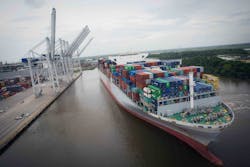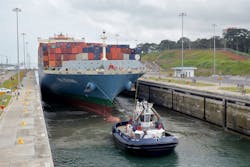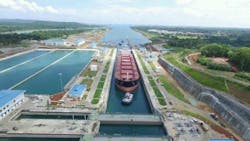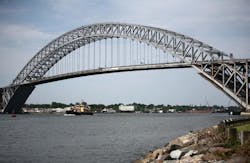As the expanded Panama Canal nears its first anniversary, more East Coast ports are receiving record-breaking containerships. However, there are concerns a lack of resources in Panama has resulted in fewer of the larger Neopanamex ships moving through than initially projected.
“A shortage of tugs and trained crews has limited the [Panama Canal] Authority’s ability to efficiently move the mega-ships through the locks. Instead of the anticipated 12 vessel transits per day through the expanded canal, only a maximum of six are being completed,” said Captain Don Marcus, president of the International Organization of Masters, Mates & Pilots (IOMMP).
The Canal's new locks opened for business on June 26, 2016, providing passage for ships with a maximum of about 13,000 twenty-foot equivalent units (TEUs), up from 5,000 TEUs.
Marcus told Fleet Owner large ships are having difficulty navigating the new locks, a problem compounded by the shortage of modern tugboats and trained captains.
“I don’t think [U.S.] ports are aware of the fact they may not get as many ships as they are anticipating” if the Panama Canal Authority does not take action, Marcus said.
If there are problems, “this is the first we have heard of it,” Joe Harris, spokesman for the Port of Virginia, told Fleet Owner.
He added: “We are not seeing any hiccups. What we are seeing are larger vessels.”
Through April, the number of ships calling on Virginia ports are down slightly, but there has been a 7.6 percent increase in TEUs, the port said. Similarly, the Georgia Ports Authority reported a record 350,104 TEUs were handled during May, 11.6 percent higher than May 2016.
In recent weeks, the OOCL France and COSCO Development have visited Virginia, Georgia and other East Coast ports. The capacity of each ship is about 13,000 TEUs.
“It’s evident shipping lines are deploying larger vessels and cargo exchanges through the Panama Canal," said Griff Lynch, GPA’s executive director.
IOMMP’s Marcus said he knows of one ocean liner that is not sending its larger ships through the new locks, opting instead for the “more reliable” older ones. An executive with that company declined to speak with Fleet Owner.
The Panama Canal Authority did not return messages seeking comment for this story, but published a statement in May disputing IOMMP’s claims.
“The expanded Panama Canal’s performance has far exceeded expectations . . . setting monthly and daily tonnage records, attracting 15 new liner services, and welcoming an average of six daily Neopanamax transits when forecasts originally anticipated only two to three transits a day for the first year of operation.”
On June 1, the Authority announced a proposal “to provide additional incentives to the containership segment - the largest user of the expanded Canal” by lowering toll rates. It also plans to raise fees on liquefied petroleum gas and liquefied natural gas vessels.
"The proposed modifications safeguard the competitiveness of the waterway, the value of the route, and facilitates the Canal's goal of providing an efficient and reliable service to the global shipping community," said Panama Canal Administrator Jorge L. Quijano.
For Paul Bingham, an executive with EDR Group and former consultant who has worked with the Panama Canal and Suez Canal, it is too soon to make a definitive decision on the expansion.
“It is not fair to judge an expansion of this magnitude and size based on the performance of the first year,” he said.
Bingham noted there has not been the immediate “enormous swing of cargo” that some had predicted. He also suggested some ocean liners may be holding off on fully utilizing the expanded Panama Canal until the Bayonne Bridge construction project is completed.
That ongoing project to raise the bridge will allow the larger vessels to access the Port of New York and New Jersey.
Bingham outlined several other factors having an effect on the Canal. First is growing competition from the Suez Canal as Egypt aggressively invests in an expansion.
There is continued financial pressure on the entire industry, highlighted by the bankruptcy of Hanjin Shipping and the continued oversupply of large ocean vessels. In addition, the risk of trade disruptions are growing as the Trump administration moves forward, Bingham said, noting the softwood lumber dispute with Canada as an example.
Bingham summed it up by saying the “uncertainty” facing ports and ocean carriers “is as great as I have seen in a very long time.”
It creates tough choices for U.S. ports considering further dredging plans.
“There is no reason to believe trade won’t continue to grow slowly. . . [but ports may] have a hard time making infrastructure decisions when they won’t know the answer for a decade or more if they made the right decision.”
About the Author
Neil Abt
Neil Abt is a former FleetOwner editor who wrote for the publication from 2017 to 2020. He was editorial director from 2018 to 2020.



